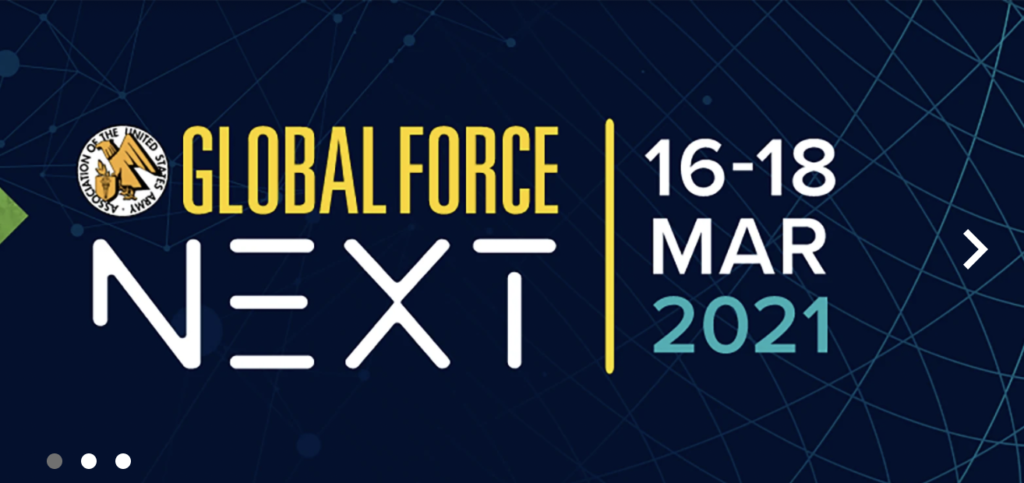
Association of the US Army’s Global Force Next conference logo
WASHINGTON: Even as it labors over uplinks and downloads for its virtual Global Force Next conference this week, the Association of the US Army aims to do its next big conference, its flagship Annual Meeting, at least partially in person in Washington, DC.
“Hopefully, the city will cooperate and we can get back into the [Walter E. Washington] Convention Center,” said retired Lt. Gen. Guy Swan, AUSA VP for education. “It won’t be on the scale of the historic event you’ve been to” in past Octobers, he said: The goal is “a reasonable in-person presence combined with a virtual presence.”
AUSA definitely looks forward to having in-person events again, especially the conference halls packed with exhibitors that are a major source of income. Virtual sponsorships fill only part of the gap. That said, “the revenue side of this [pandemic] hasn’t been catastrophic,” Swan told me: “While we have lower revenue, we do have lower costs” – since you’re not physically renting facilities, book hotel rooms, and flying staff around – “[so] it’s probably a wash.”
At the same time, the virtual dimension forced on conferences by COVID is never going to go away, Swan emphasized, because it expands the potential audience too much to give it up. And that’s just one of many lessons AUSA has learned during the pandemic.
It’s been a year of tremendous adaptation – and not a little whiplash – for AUSA’s staff. In March 2020, with COVID erupting nationwide, AUSA abruptly canceled its spring conference in Huntsville, Ala. “we didn’t have any time to react,” Swan told me. “It was canceled completely…. Our advance team was headed there and we literally stopped them at the airport.”
Over the next five months, AUSA wrestled with whether to hold its annual meeting in person or virtually, opting only in August to hold the October event entirely online. “We had lessons learned” from that experience, Swan said, all of which they’ve implemented for this week’s Global Force conference.
First and foremost: Virtual conferences take a lot of human labor to set up. “It was staggering in terms of staff demand,” Swan told me, “hundreds and hundreds of hours putting together a virtual event… a three or four-fold expansion of what our staff has to do.”
Why so much work? For one thing, while it’s hard enough lining up speakers for an in-person event, once you do confirm them, they book their own plane tickets and hotel rooms, and then they just show up. For a virtual conference, you have to spend a lot of time checking each individual speaker’s connection, because each individual speaker may have a different combination of hardware, software, and (especially) firewalls that interact differently – and potentially very poorly – with the system the conference is using.
“We learned that lesson the hard way in October, when some people disappeared into the ether when we were trying to get them to speak,” Swan said. So for Global Force, AUSA is making sure to hold technical rehearsals for all its panels – not to practice remarks but to ensure all the digital connections really connect.
Another “big lesson,” Swan told me: people’s attention span while sitting at a screen is significantly shorter than in-person. At last fall’s virtual Annual Meeting, panels routinely ran for over an hour, as they do at the in-person version. That was too much, AUSA learned. So for Global Force, panels max out at an hour, keynote speeches at 30 minutes. [UPDATE: Actually, a lot of panels went 75 minutes — still shorter than the traditional norm]
Of course, a lot of people don’t go to conferences for the panels and speeches: They go to network with government officials and industry executives in the hallways and at exhibitor displays. That’s not physically possible during the pandemic, but for Global Force, AUSA is implementing networking chatrooms and virtual appointments.
Sometimes all this becomes too difficult. AUSA cancelled its annual LANPAC conference, normally held in Hawaii, because the Pacific audience is so spread out it’s impossible to schedule events at times that work for everyone: “You’re talking time zones from Washington to Seoul,” Swan said.
But for a US-focused event like this week’s Global Force or October’s annual meeting, Swan told me, the ability to reach a widely dispersed audience has proven to be a huge advantage. Industry officials can tune in from offices and factories across the US, troops from bases around the country. “Once we get back to in-person, we’re not going to drop the virtual,” he said. “It’s become too valuable for us.”






















